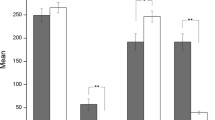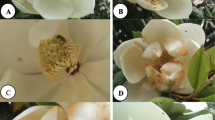Abstract
Plants that depend on a single species of insect pollinator must often contend with infrequent and unpredictable visitation. Prolongation of floral receptivity comes at the cost of reduced male and/or female reproductive success among older flowers. Fig trees (Ficus spp.) have a highly specific pollination symbiosis and individual inflorescences (syconia) that remain receptive for days or weeks. Reproductive success in monoecious fig trees involves production of both seeds and fig wasp offspring. We assessed whether the reproductive output of individual syconia changes with the length of time they waited for pollination, and whether the relative female and male reproductive success also changes. A pollination experiment was conducted in an SE Asian monoecious fig tree Ficus curtipes, in which receptive syconia were covered with mesh bags to exclude wasps and pollinated by single pollinators of this fig tree at their different receptive ages. When the syconia matured their size and contents were recorded. Seed quality was also assessed. The results showed that pollinators entered syconia that had been waiting for up to 36 days. The frequencies of abortions among syconia pollinated at different ages were low throughout. The number of un-utilised flowers increased progressively in older syconia. Seed production was highest in syconia entered on the first day of receptivity, whereas pollinator production peaked in syconia pollinated on day 12, then declined in older syconia. Consequently, overall reproductive efficiency declined with syconium age and floral sex allocation became more male-biased in older syconia. Older syconia also produced lighter seeds. These results suggest that un-pollinated syconia of F. curtipes can remain receptive for several weeks. This makes pollination of each syconium more likely, but at the cost of reduced productivity and with more ovules allocated to male function. However, the prolongation of floral receptivity has significance for the co-adaptation between syconia and fig wasps and for the evolution of the fig tree-fig wasp symbiosis.



Similar content being viewed by others
References
Ahmed S, Compton SG, Butlin RK, Gilmartin PM (2009) Wind-borne insects mediate directional pollen transfer between desert fig trees 160 km apart. Proc Natl Acad Sci USA 106:20342–20347
Ashman TL, Schoen DJ (1994) How long should flowers live? Nature 371:788–790
Bronstein JL (1988) Limits to fruit production in a monoecious fig: consequences of an obligate mutualism. Ecology 69:207–214
Dunn DW, Yu DW, Ridley J, Cook JM (2008) Longevity, early emergence and body size in a pollinating fig wasp––implications for stability in a fig-pollinator mutualism. J Anim Ecol 77:927–935
D]unn DW, Jansen-González S, Cook JM, Yu DW, Pereira RAS (2011) Measuring the discrepancy between fecundity and lifetime reproductive success in a pollinating fig wasp. Entomol Exp Appl 140:218–225
Evanhoe L, Galloway LF (2002) Floral longevity in Campanula americana (Campanulaceae): a comparison of morphological and functional gender phases. Am J Bot 89:587–591
Ghana S, Compton SG (2012) Factors influencing realized sex ratios in fig wasps: double oviposition and larval mortalities. J Insect Behav. doi:10.1007/s10905-011-9294-4
Gu D, Compton SG, Peng Y, Yang D (2012) ‘Push’ and ‘pull’ responses by fig wasps to volatiles released by their host figs. Chemoecology. doi:10.1007/s00049-012-0108-8
Herre EA, Jandér K, Machado CA (2008) Evolutionary ecology of figs and their associates: recent progress and outstanding puzzles. Annu Rev Ecol Evol Syst 39:439–458
Itagaki T, Sakai S (2006) Relationship between floral longevity and sex allocation among flowers within inflorescences in Aquilegia buergeriana var. oxysepala (Ranunculaceae). Am J Bot 93:1320–1327
Janzen DH (1979) How many babies do figs pay for babies? Biotropica 11:48–50
Jousselin E, Rasplus JY, Kjellberg F (2001) Shift to mutualism in parasitic lineages of the fig/fig wasp interaction. Oikos 94:287–294
Khadari B, Gibernau M, Anstett MC, Kjellberg F, Hossaert-McKey M (1995) When figs wait for pollinators: the length of fig receptivity. Am J Bot 82:992–999
Kjellberg F, Doumesche B, Bronstein JL (1988) Longevity of a fig wasp (Blastophaga psenes). Proc K Ned Akad Wet C 91:117–122
Kjellberg F, Jousselin E, Bronstein JL, Patel A, Yokoyama J, Rasplus JY (2001) Pollination mode in fig wasps: the predictive power of correlated traits. Proc R Soc B-Biol Sci 268:1113–1121
Marshall DL, Reynolds J, Abrahamson NJ et al (2007) Do differences in plant and flower age change mating patterns and alter offspring fitness in Raphinus sativus (Brassicaceae)? Am J Bot 94:409–418
Marshall DL, Avritt JJ, Maliakal-Witt S, Medeiros JS, Shaner MGM (2010) The impact of plant and flower age on mating patterns. Ann Bot 105:7–22
Mawdsley NA, Compton SG, Whittaker RJ (1998) Population persistence, pollination mutualisms, and figs in fragmented tropical landscapes. Conserv Biol 12:1416–1420
McKey D (1989) Population biology of figs: applications for conservation. Experientia 45:661–673
Norman GR, Streiner DL (2008) Biostatistics: the bare essentials, 3rd edn. BC Decker, Hamilton
Obeso JR (2002) The costs of reproduction in plants. New Phytol 155:321–348
Primack RB (1985) Longevity of individual flowers. Annu Rev Ecol Syst 16:15–37
Rathcke BJ (2003) Floral longevity and reproductive assurance: seasonal patterns and an experimental test with Kalmia latifolia (Ericaceae). Am J Bot 90:1328–1332
Schoen DJ, Ashman TL (1995) The evolution of floral longevity: resource allocation to maintenance versus construction of repeated parts in modular organisms. Evolution 49:131–139
Shanahan M, So S, Compton SG, Corlett R (2001) Fig-eating by vertebrate frugivores: a global review. Biol Rev 76:529–572
Software S (2006) SigmaPlot for Windows version 10. Systat Software, Chicago, IL
SPSS (2004) SPSS 13.0 for windows. SPSS, Chicago, IL
Steinacher G, Wagner J (2010) Flower longevity and duration of pistil receptivity in high mountain plants. Flora 205:376–387
Suleman N, Raja S, Zhang Y, Compton SG (2011) Sexual differences in the attractiveness of figs to pollinators: females stay attractive for longer. Ecol Entomol 36:417–424
van Doorn WG (1997) Effects of pollination on floral attraction and longevity. J Exp Bot 48:1615–1622
Weiblen GD (2002) How to be a fig wasp. Annu Rev Entomol 47:299–330
West SA, Herre EA (1994) The ecology of the New World fig-parasitizing wasps Idarnes and implications for the evolution of the fig-pollinator mutualism. Proc R Soc B-Biol Sci 258:67–72
Zhang FP, Peng YQ, Guan JM, Yang DR (2008) A species of fig tree and three unrelated fig wasp pollinators. Evol Ecol Res 10:611–620
Zhang FP, Peng YQ, Compton SG, Yang DR (2009) Floral characteristics of Ficus curtipes and the oviposition behavior of its pollinator fig wasp. Ann Entomol Soc Am 102:556–559
Zhang Y, Yang DR, Peng YQ, Compton SG (2011) Costs of inflorescence longevity for an Asian fig tree and its pollinator. Evol Ecol. doi:10.1007/s10682-011-9525-3
Acknowledgements
We thank Jinyuan Zhang for experiment assistance. This work was funded by the Chinese Natural Science Foundation (30970439 and 30970403).
Author information
Authors and Affiliations
Corresponding author
Rights and permissions
About this article
Cite this article
Gu, D., Yang, D., Compton, S.G. et al. Age at pollination modifies relative male and female reproductive success in a monoecious fig tree. Symbiosis 57, 73–81 (2012). https://doi.org/10.1007/s13199-012-0178-y
Received:
Accepted:
Published:
Issue Date:
DOI: https://doi.org/10.1007/s13199-012-0178-y




